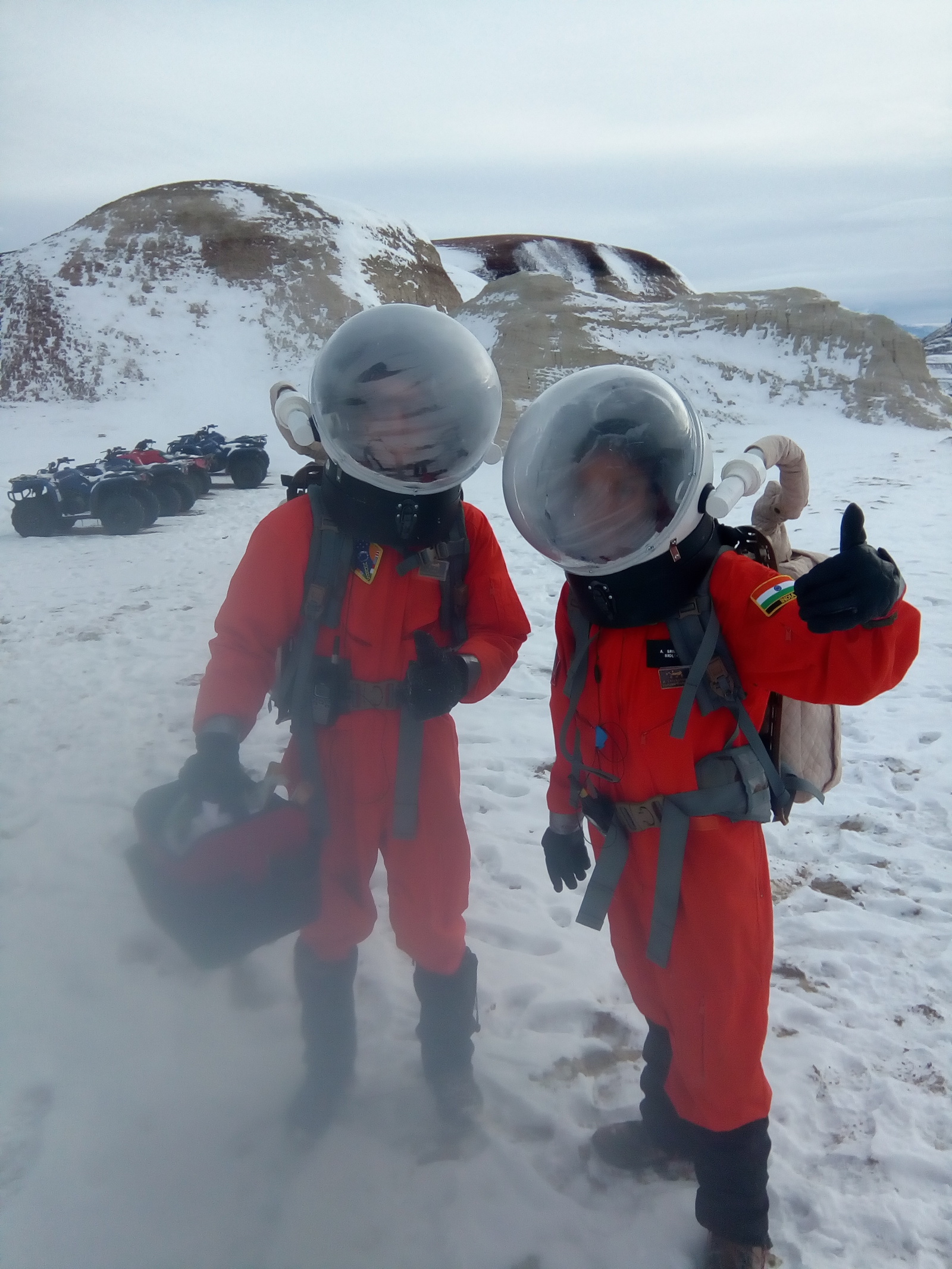
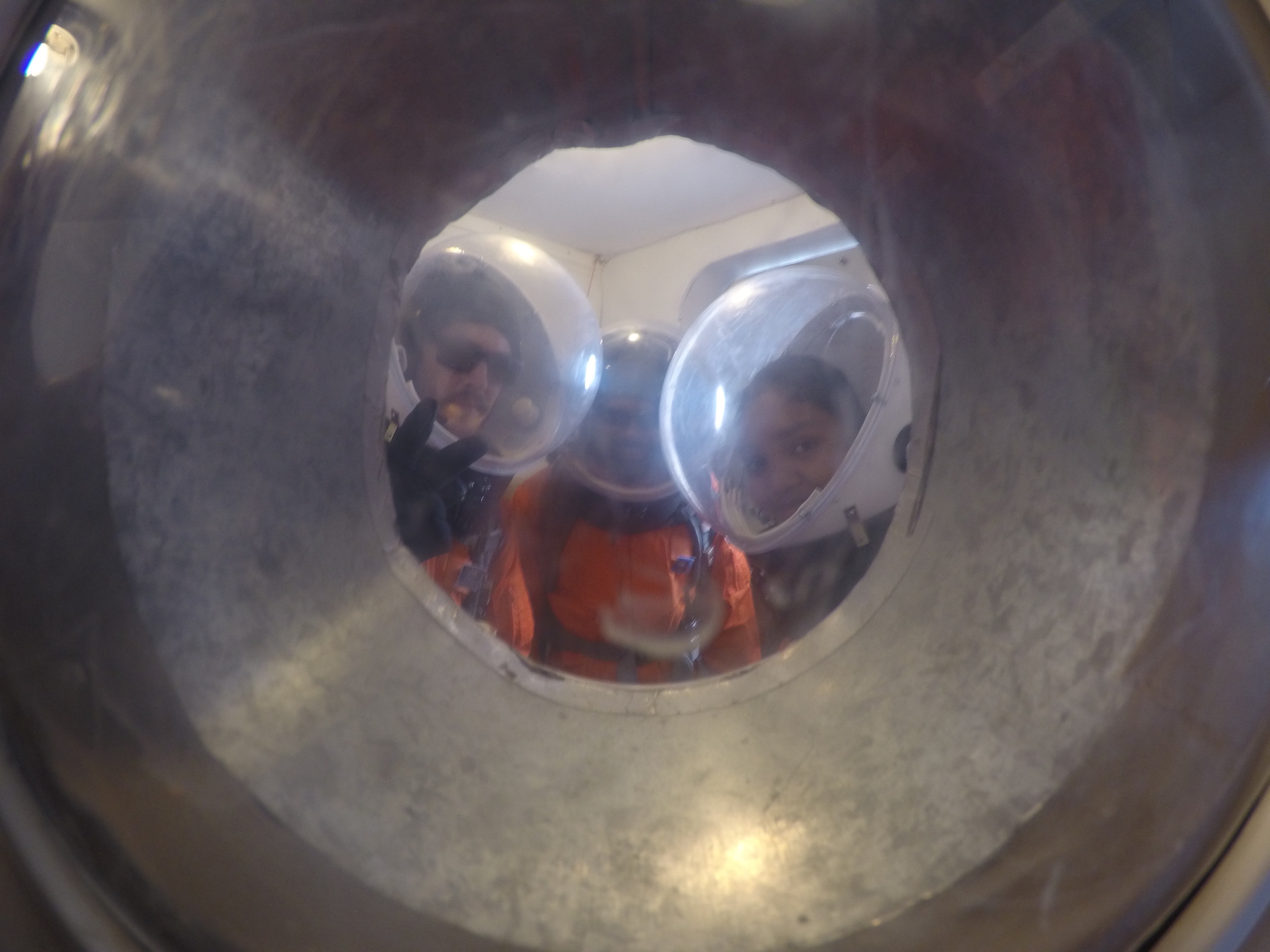

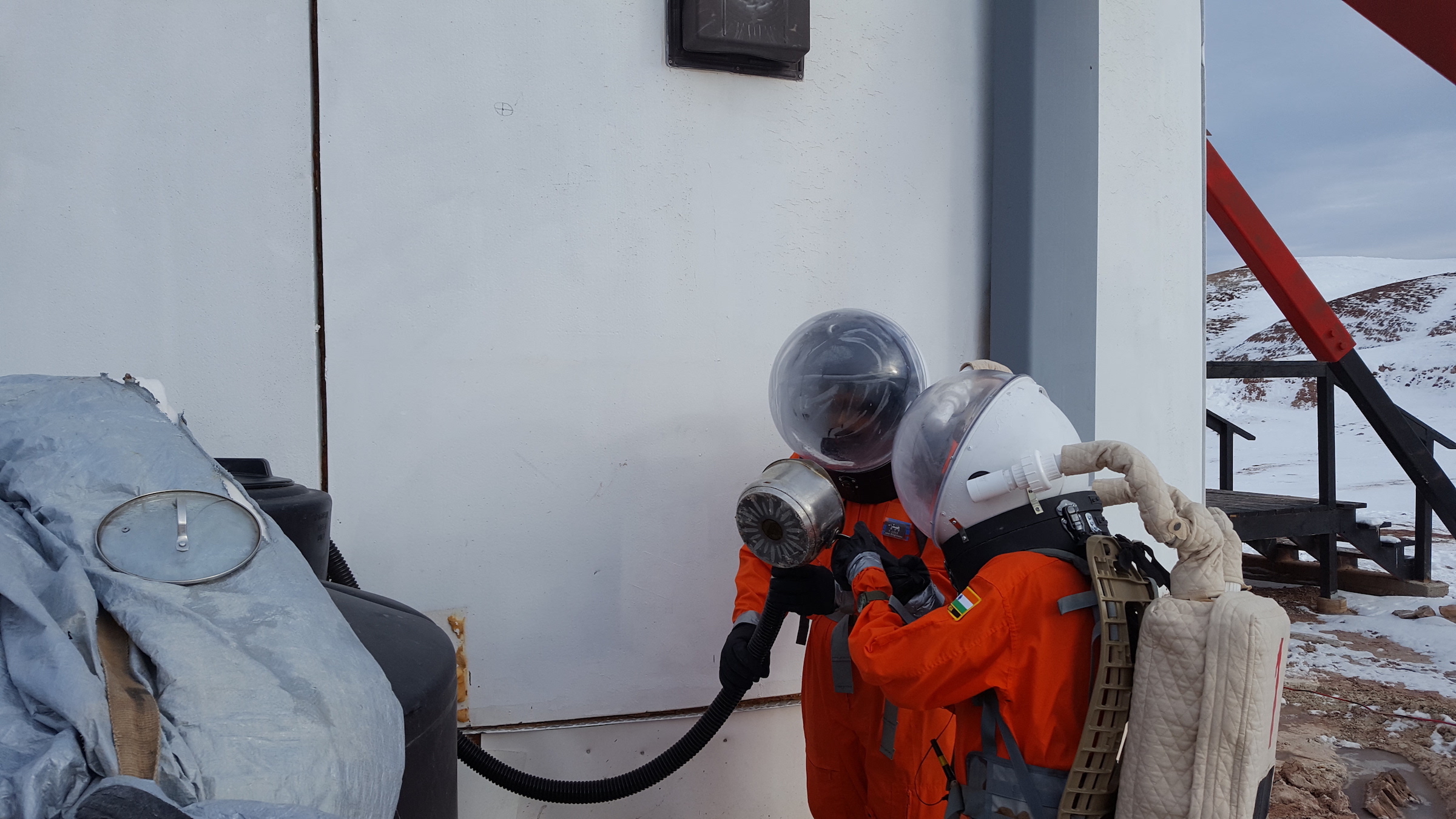

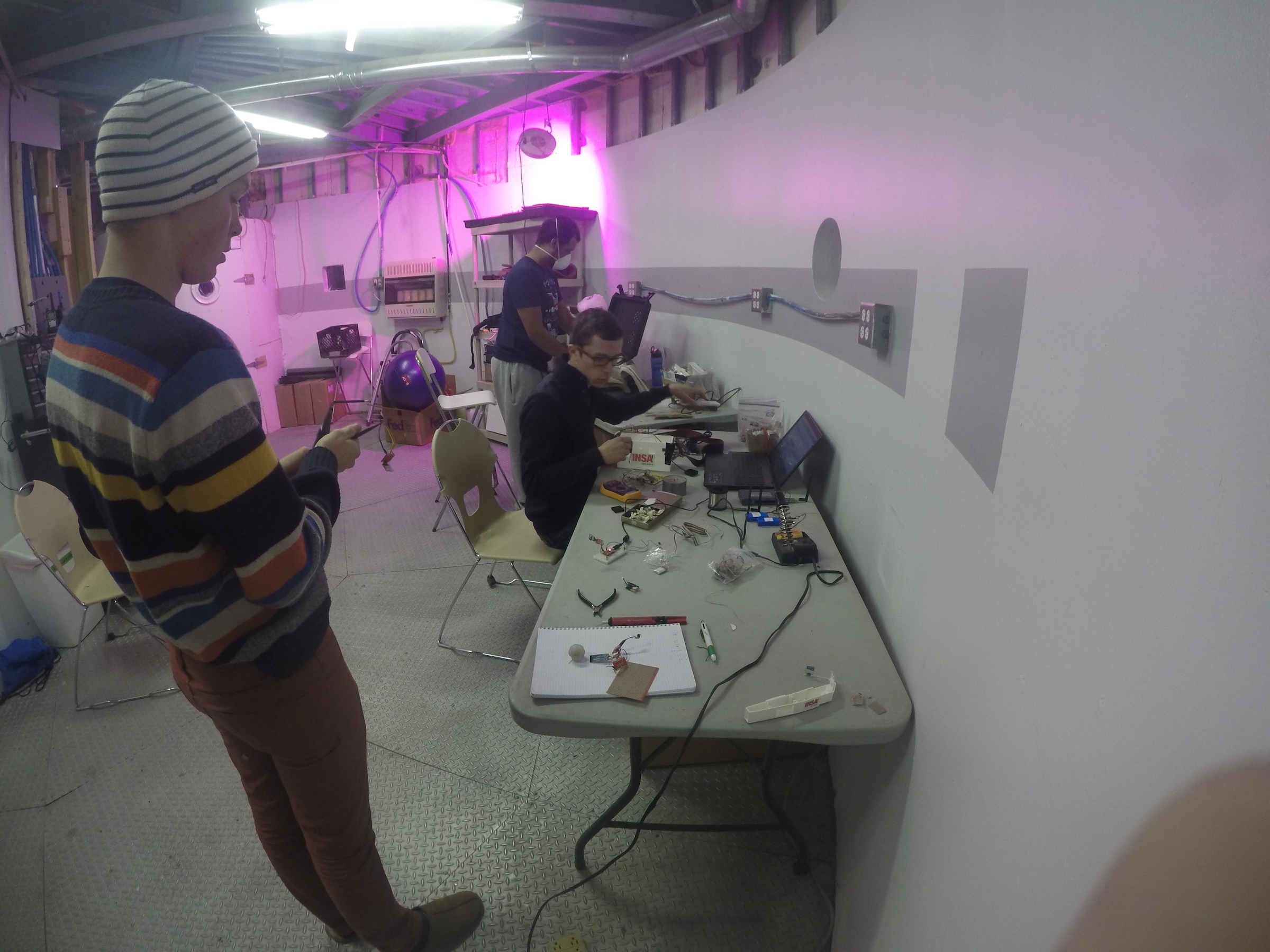
GreenHab Report
GreenHab Facility Update and Recommendations: Heater is still not working. The GreenHab is more hospitable than outside but only slightly. Temperature last night inside the GreenHab was: 30F and temperature today was: 35F. On sunny days it is also getting too hot for some plants (even though the heater was turning off appropriately upon reaching set temperature). On Sol 4 it reached 105F in the GreenHab at 2:30. So until the heater and A/C are functioning I recommend keeping plants in the Hab or closely monitoring the weather and moving them accordingly. Another option is to move the grow tent into the Science Dome and keep the tent in there with the grow light, but this only allows for a very small amount of plants to be grown and could still be too cold. I will move the grow tent in there and measure temperature.
Plant Growth Update: Due to the heater no longer functioning I have moved the plants and a grow light into the Hab to keep the plants healthy. After 24 hours they are doing quite well on the first floor of the Hab and already responding well to the new grow light installation. I am beginning new growth for Crew 173. 20 spinach seeds planted in the growth matrix and I will post updates for Crew 173’s information as they develop.
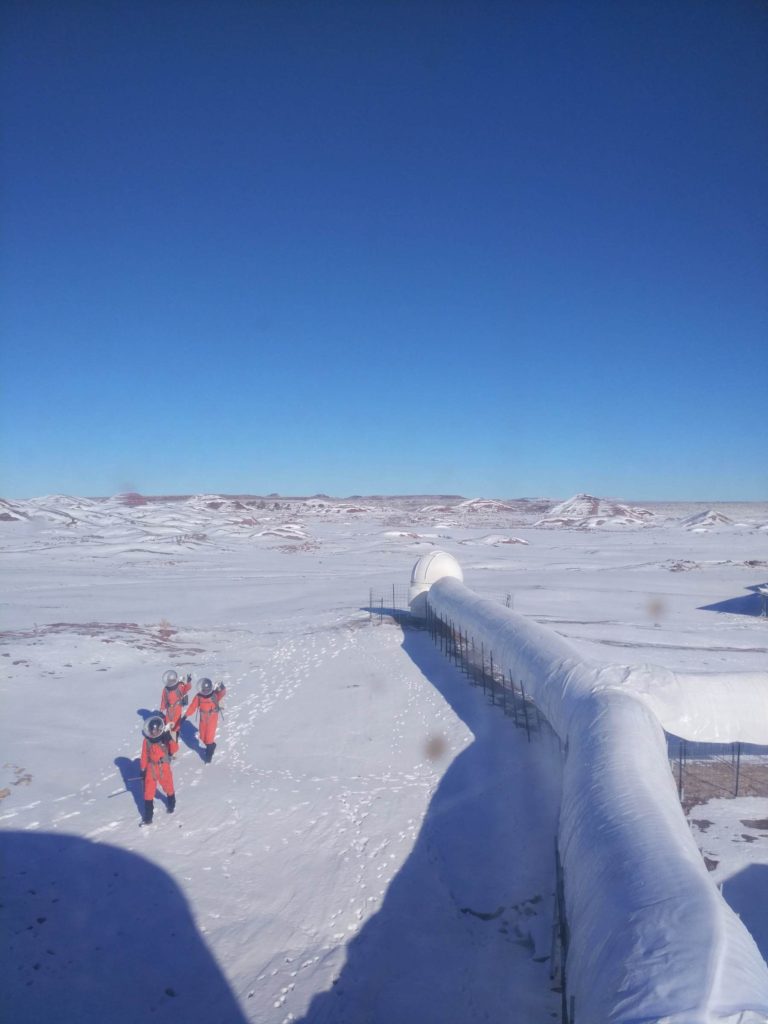
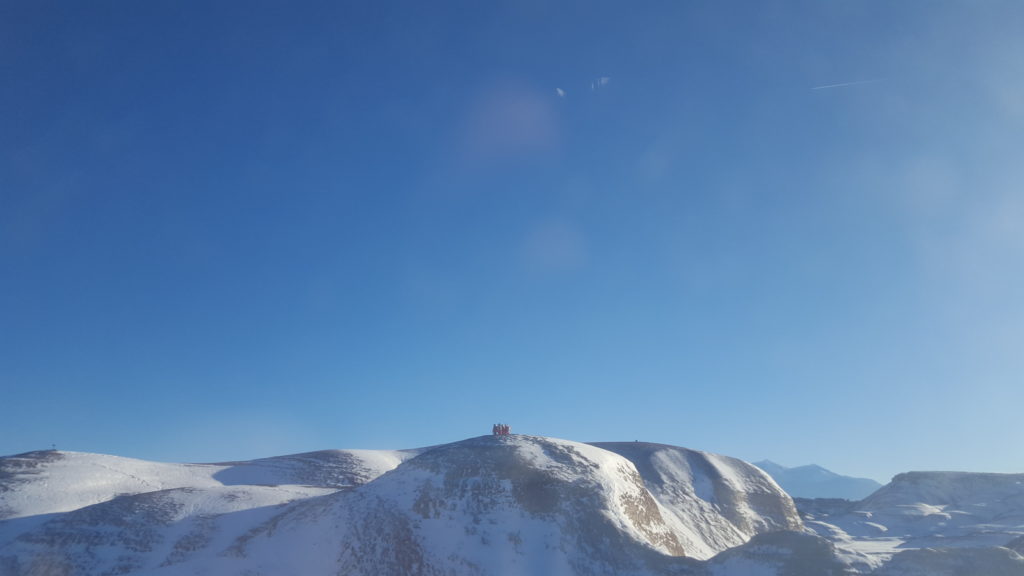
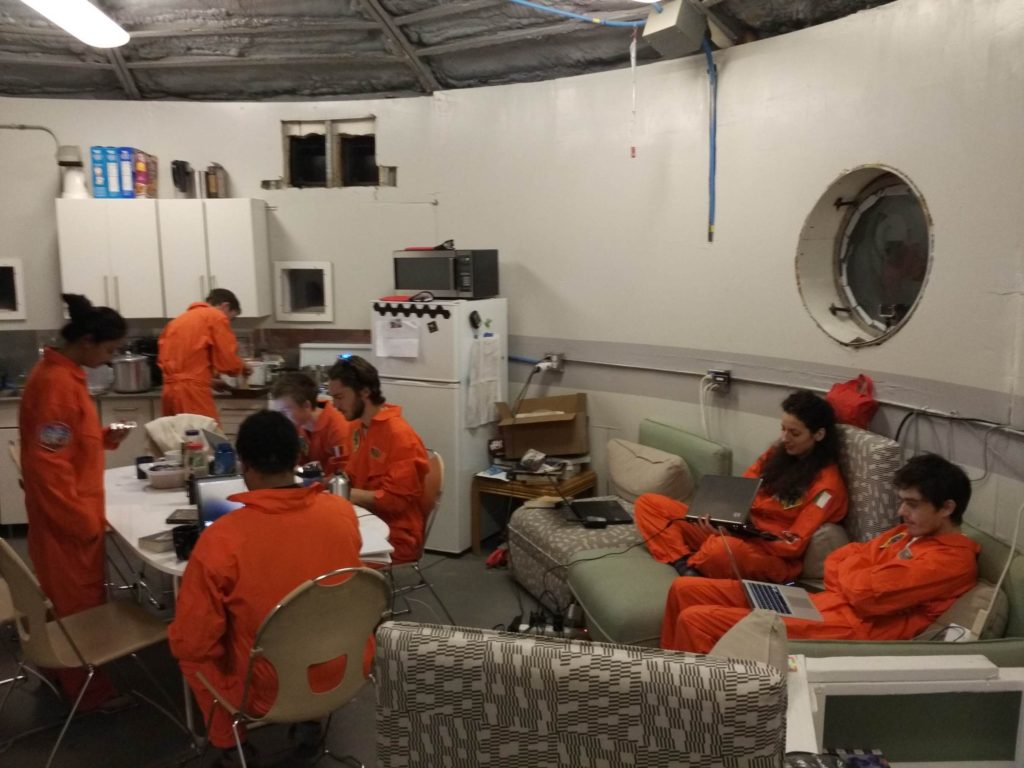
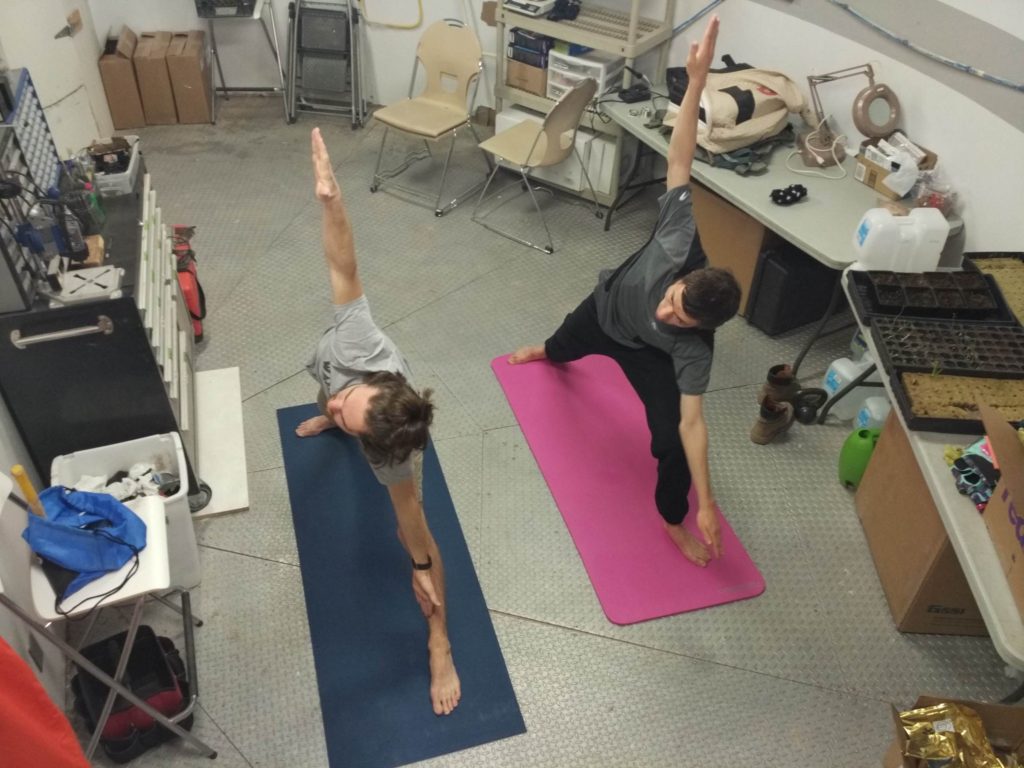
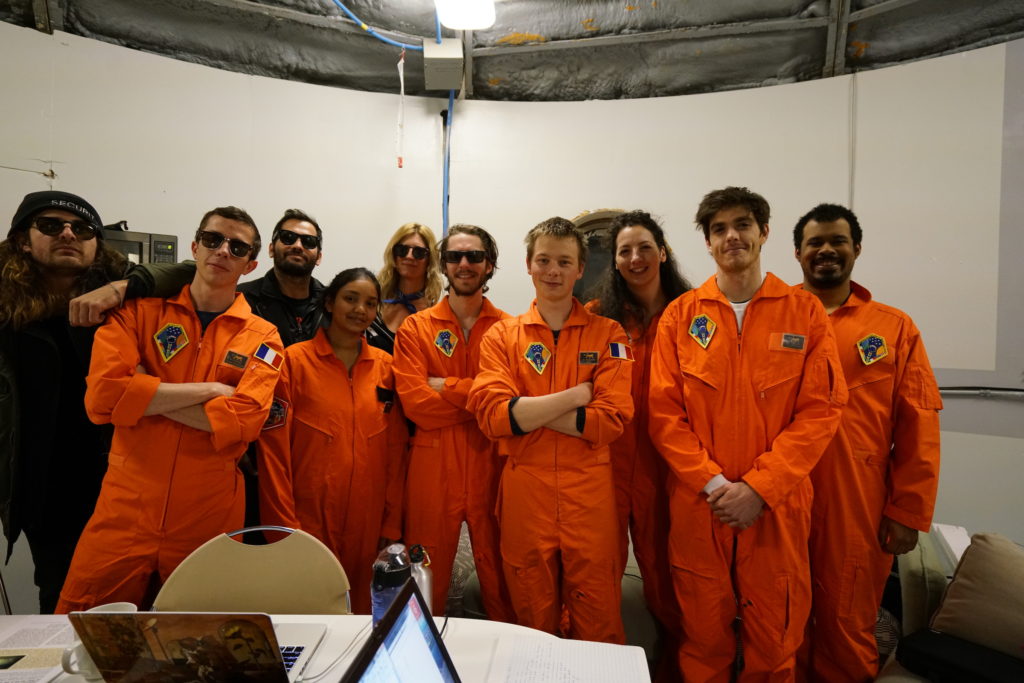
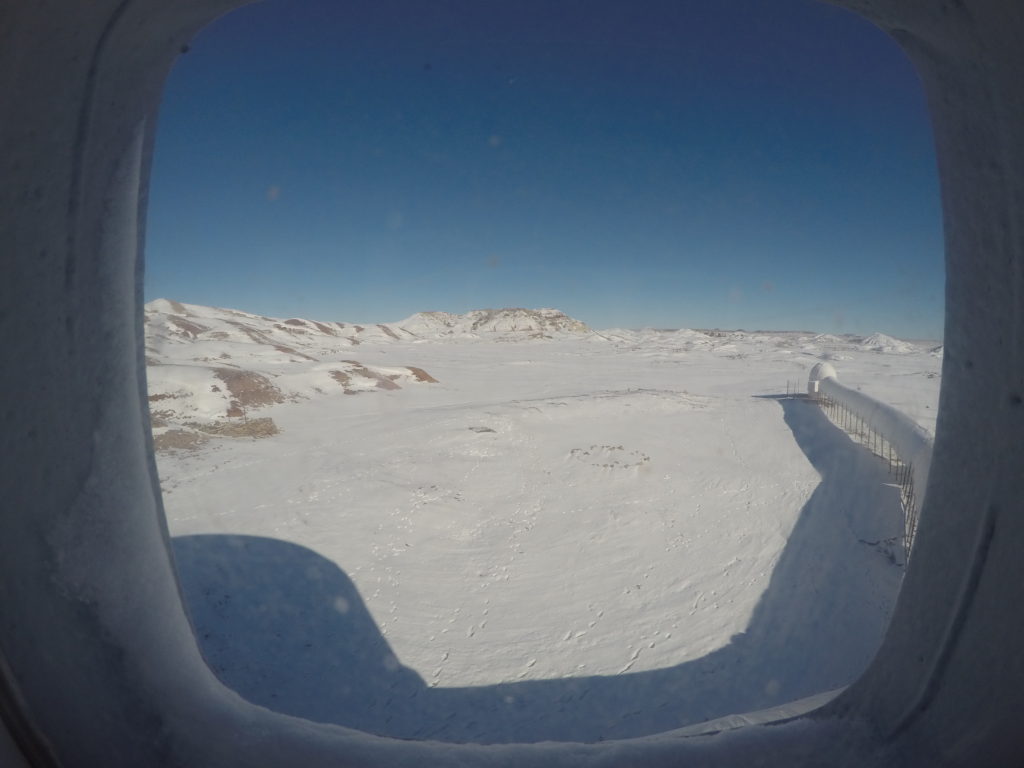
It started snowing yesterday at 4pm, and didn’t stop until after we were asleep. We woke up this morning to an all white Martian landscape with no “Red Planet” in sight.
Back on Earth this would be primetime for a snow day, but sadly that was not the case here on Mars. We have numerous life support systems that need checking, every day, regardless of weather. However, Commander Ilaria did let us sleep in for an extra hour, so the crew was happy and rested to begin our day of operations.
We waited until 2pm, the hottest time of the day, to go out on our daily engineering EVA. Troy led Gwendal and I to check the propane, diesel generator, water tank levels, clean the solar panels of snow, and fill the oil & gas in the ATVs. This took about 15 minutes, and we were eager to get back to the warmth of the Hab. At that same time, our friends from the Solar System News Network – RYOT – reappeared. They wanted to ask us more questions about our mission, and to better understand the motives of subjecting ourselves to this analog simulation. Our scheduled quarter hour EVA turned into a frigid 2 hours. The highlight was hiking up to the nearest hill that overlooks the MDRS campus for panorama shots. The scenery was literally breathtaking, and the crew drank in the view before deciding that we might freeze if we stay out much longer. Back to the safe confines of the Hab came the order.
The Hab’s heating furnace never felt so good when we finally got back to it’s warmth. My toes felt like ice cubes and took some time to defrost. Our lazy day had unexpectedly turned into a full day of running around, but that is par for the “Mars” course. Be ready for anything!
Dinner and CAPCOM are coming up, and it seems like the crew cant wait to get in their bunks for the night. A good night’s rest is needed after the last couple of days. Crew 172 signing off.
END TRANSMISSION


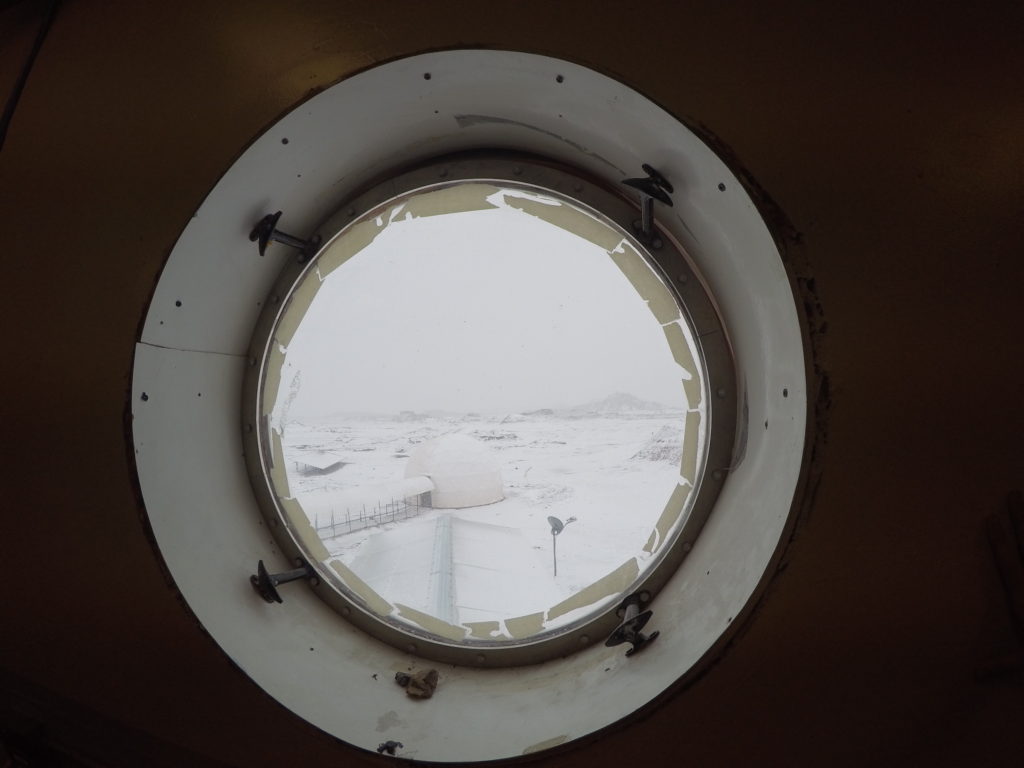
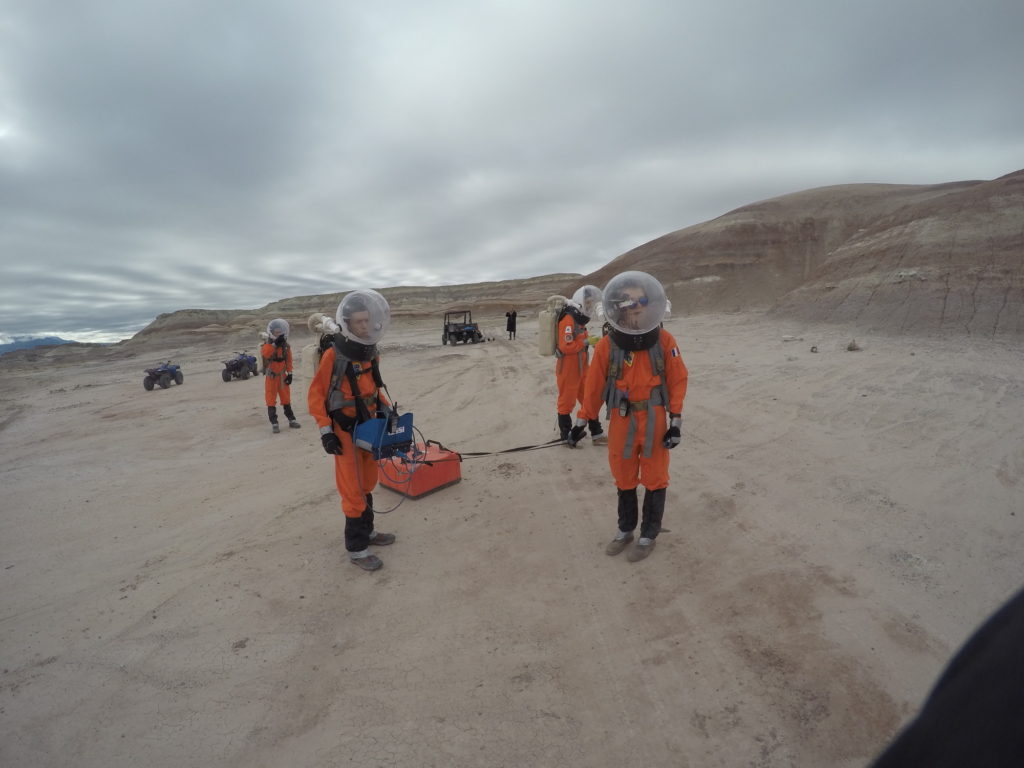
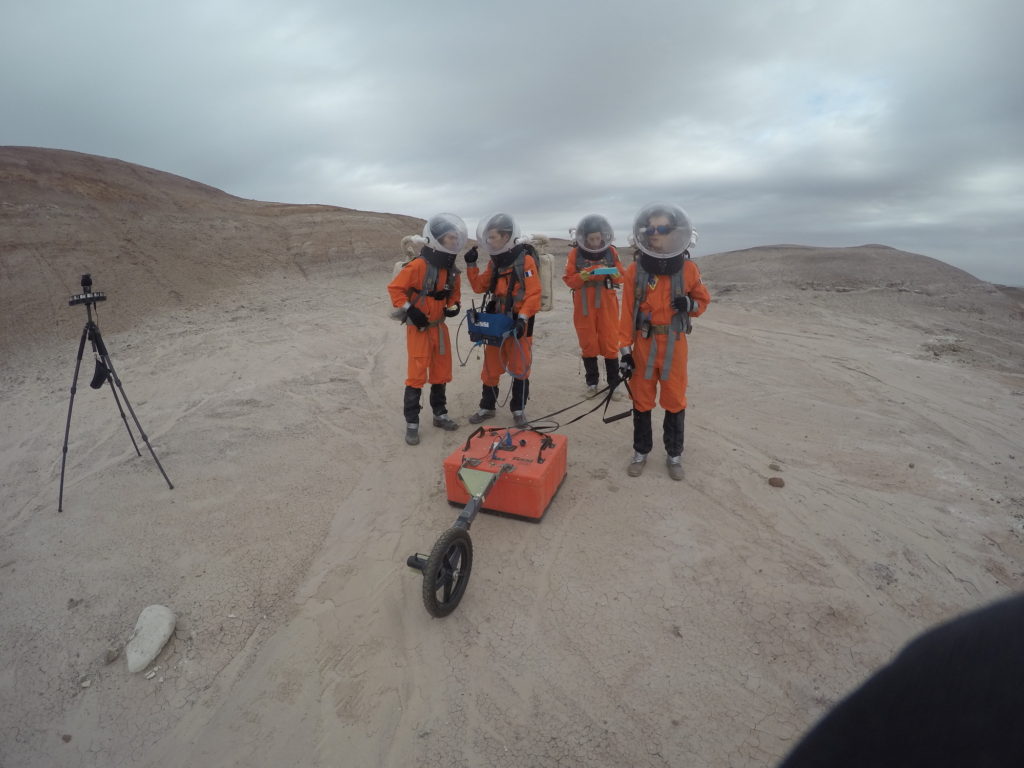
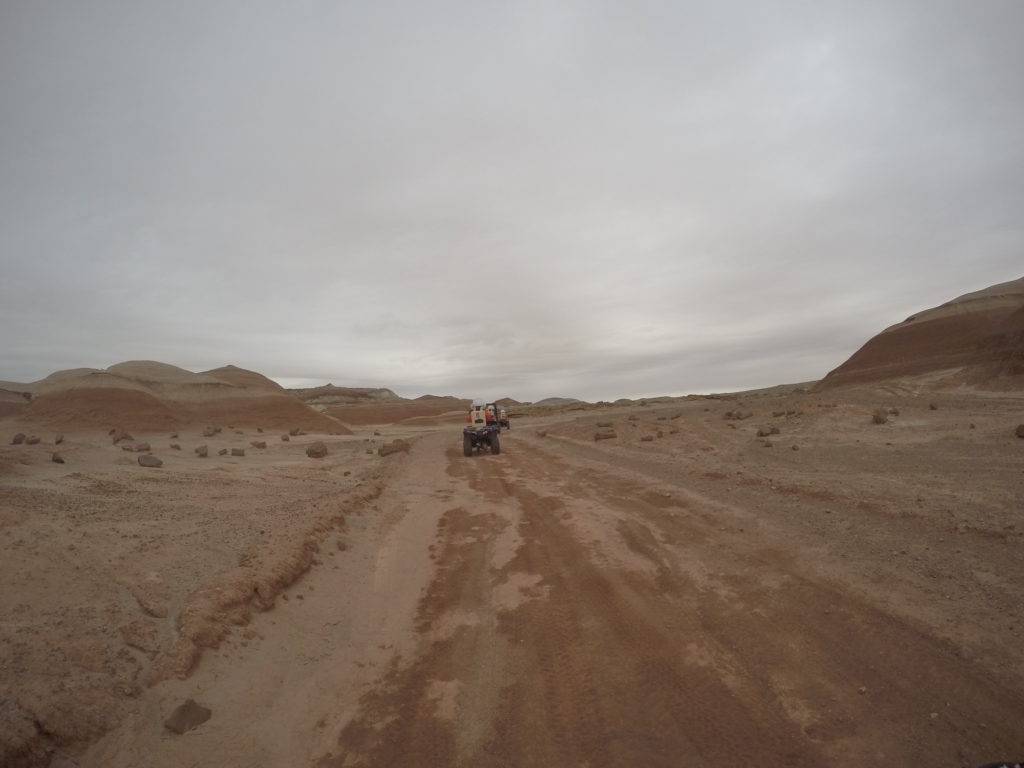
Today we were visited by Aliens! And with visual and audio equipment to boot. The three of them were part of a peace-keeping and research envoy from the Solar System News Network – RYOT.
We were not expecting any company until after the weekend, when our mid mission resupply would arrive, but that was only supposed to be robotic visitors. This was a welcome surprise, and the crew jumped at the opportunity to convey the importance of our mission. Myself, Patrick (Green Hab), Gwendal (Health and Safety), Pierrick (Scientist), and Commander Ilaria suited up to greet them outside the Hab. The RYOT crew peculiarly were not wearing any life support system – as far are we could tell – and were not fazed by Mars’s lower 0.006 ATM. For those keeping score back on Earth, remember you live at 1.0 ATM. Thus, the reason we humans wear Oxygenator packs when we traverse the Martian landscape. The aliens wanted to see what type of research projects we were going to undertake while on the red planet – we happily obliged.
The crew took our large rover and three ATVs to a nearby waterbed to demonstrate the Frenchmen’s Ground Penetrating Radar, while the visitors observed from close by. The weather began to turn for the worst halfway through our planned expedition, so we scraped the rest of the EVA, even though we had plenty of oxygen and fuel. Good thing because almost as soon as the airlock door was closed, with all crew and visitors inside, it began to snow outside. I know! Snow! In the Martian desert! We are not located at either of the poles, so a bit odd. However, we are at 1,300m above sea level, so the elevation is the likely culprit for us seeing precipitation. After a few hours, it now looks like a winter wonderland. The first time the crew has seen anything other than a reddish-brown landscape since arriving.
Back inside the Hab, Anushree (XO & Astrobiologist) gave our new friends a tour of the science dome where most of her research takes place. She is the most seasoned Marsnaut out of all of us. She participated in the first 80 day analog mission, earlier this year, of a total 160 day simulation that will have its second 80 days take place this summer in the Arctic. Our 14 day sim is a walk in the park for her. Anushree’s project is trying to answer the question: “Is there a type of unique micro-organism that could survive extremely high salt concentrations?” Why salt you ask? Well two main reasons: first, a previous Mars robotic rover mission found gypsum (a type of salt), and secondly, there are more than 600 locations on the southern hemisphere of Mars where scientists have discovered salt deposits through using a tool on a Martian orbiter called THEMIS (Thermal Emission Imaging System). Yesterday, I told you about how analog missions are fantastic test beds for hypothesis’ before applying the potential solution (experiment, procedure, equipment, etc.) on an actual spaceflight mission. We believe there is a strong possibility of brine (salty water) existing on the Martian surface in the past, with the liquid water evaporating and leaving behind only the salt as a deposit. In the left over salt, there is a chance we will find extreme environment loving micro-organisms (extremophiles) that thrive in salt (more specifically, halophiles). That COULD, don’t quote me on this, be the first sign of any life, other than that on Earth, that we (humanity) have discovered. Are you as pumped as I am about that possibility?! Woah.
After Anushree was finished explaining her work, the RYOT crew were guided to the GreenHab to talk to Patrick. He explained to our visitors the benefits, there are quite a few, of being able to grow food on Mars. The first advantage is the physiological benefit of having fresh food in your diet (more nutrient dense, less preservatives), and the second is that there is an emotional benefit to growing your own food and being in a green, humid, and natural environment. Time in a greenhouse environment has been shown to be a major de-stressor on long duration Antarctic missions. Lastly, the satisfaction of eating food that you yourself grew is invaluable. Here at MDRS, we are installing a sustainable aquaponics system to efficiently grow fresh food. There is also space for visiting researchers to run their own experiments in this unique environment. I can’t wait to try Martian sweet potatoes in my mom’s homemade casserole recipe!
During our “tour,” the RYOT trio set up 360 degree cameras at every location that will soon allow any interested party to access an interactive map of the MDRS campus. The idea is that you will be able to “teleport” yourself (not physically, but through VR goggles or the Internet) to each different setting: The Hab (Engineering Bay, Airlock, common area, and crew quarters), The Science Dome, The GreenHab, The Observatory, and on EVA with our transport vehicles.
The aliens stated they will be back tomorrow to complete their tour and interview the other crew members. Now CAPCOM window is open, and the crew is wiped from a long day of entertaining our “guests.” Hot dinner and a movie is on the docket in this freezing weather. Until tomorrow, Crew 172 signing off.
END TRANSMISSION
GreenHab Report
Facility Update: The heater is officially working in the GreenHab now. The temperature inside the facility was 13 C when I left this afternoon at 4PM with an outdoor temperature of -2 C I’ve moved all the plants from the first level of the Hab into the area directly in front of the heater in the GreenHab, but still a safe distance away for their own well being and for fire safety. We shall see how they fare on this wintry night.
Other Notes: GreenHab inventory will continue tomorrow. Please reach out if you are a future crew member or GreenHab team member and would like any other information.
Patrick Gray
GreenHab Officer – Crew 172
Sol 3 Summary – Written by Nicholas McCay, Crew Journalist
Crew 172 has settled into living on the surface of another planet. It is definitely a different experience than living back on Earth.
I feel like I am a human guinea pig. I guess that is a good thing since experiments and research are the main point of analog simulations. Testing humans, equipment, and procedures inside a “controlled” but still stressful and hostile setting (environmentally, physically, and/or psychologically). In actual human spaceflight missions there are many unknowns, so sims take some of the guess work out of the “What could go wrong?” equation. We have encountered many of these unknowns before in actual missions, and sims are an ideal test bed for solutions.
I explained yesterday that some of the research we are actively testing on our mission is a possible answer to the question: “Could an astronaut bring equipment that would allow them to see a subsurface water source?” I also said that I would explain more to why we are taking mandatory naps in the day. Well… another question (lead by Commander Ilaria) that we are trying to answer in the next two weeks is: “Could astronauts wear a device while sleeping that would help them fall asleep quicker and thus improve overall sleep and performance?”
Last night we began to test that hypothesis. Each Crew 172 Marsnaut wears a semi-comfortable visor over their eyes while they begin to sleep. Inside the visor and directly in front of each closed eye is an orange lighted circle that alternatively turns on and off or stays lit the entire duration of the 30 minute sleep improvement period. At the same time, the flanges of the visor that rest on either temple have tiny speakers that play “white noise.” The idea is that these stimuli will induce the astronaut, or any user for that matter, into REM(Rapid Eye Movement) sleep faster than normal. One of the main reasons for poor sleep is not being able to fall asleep in a timely manner – this is especially an issue during stressful situations like exploring Mars – so this is a direct attempt to test a solution to that problem. I can say confidently that last night, it did not work and I had trouble falling asleep due to this being the first time we used the devices before lights out. However, I can say just as confidently that today during our 30-minute mandatory nap I experienced something completely new and promising. During my lay down, I felt like I was dreaming in and out of different situations like, but I never actual fell completely asleep. I know… Pretty trippy. Three of my crew stated they had similar experiences.
Let’s rewind a bit to before our nap. Five us went out on a walking EVA of the Martian landscape to stress us physically. Remember all the equipment that we have to wear to keep us alive in the lower atmosphere? Yeah… All of our gear and clothes weigh a total of ~ 45 lbs. Now imagine walking, basically hiking, on different terrains (sand, rock, incline, decline), with the Oxygenator pack, AND a bubble helmet that inhibits your vision while frequently fogging up enough to make it difficult to see exactly where you are stepping. Don’t forget the constrained oxygen from the suit and high altitude in our “Martian” desert. Fun times right?!?! But hey you pay your dues. Even with everything I said above, going on EVA is the crème de la crème of SIM. You really feel like an Marsnuat! The scenery (Southern Utah) is absolutely breathtaking, and is about as close to “Mars” as we can get here on Earth. (There are a few other locations: Hawaii volcanoes, The Artic Tundra, and high deserts around the world that are close. I will talk about these analogs in future posts.)
Fast-forward to after our nap. The crew was up working on their own personal projects for a couple hours. Before dinner, Gwendal (our Health and Safety Officer, and a certified paramedic in France) led us in a First Aid briefing. In the US, being an hour away from a hospital is “Wilderness,” so we are definitely in the Martian wilderness, that is for sure! We went through situations such as: bleeding, choking, concussions, and my favorite – broken bones. I have broken my arm twice in my life – comes with the territory of being the oldest of 3 brothers in TN ha…What up Jordan and Austin?!
Now it’s chow time, and I can smell an amazing curry scent. Anushree is cooking something from her native country of India. I, and the crew, are excited for some much needed spice! Remember most of the food we are eating is dehydrated, so pepper, salt, and spices are our dear friends. After dinner, we will have our normal reporting with COMMS and head to bed for another round of wearing the sleep study visor. Here is to hoping that tonight’s sleep will be better than last night! Crew 172 signing off.
END TRANSMISSION
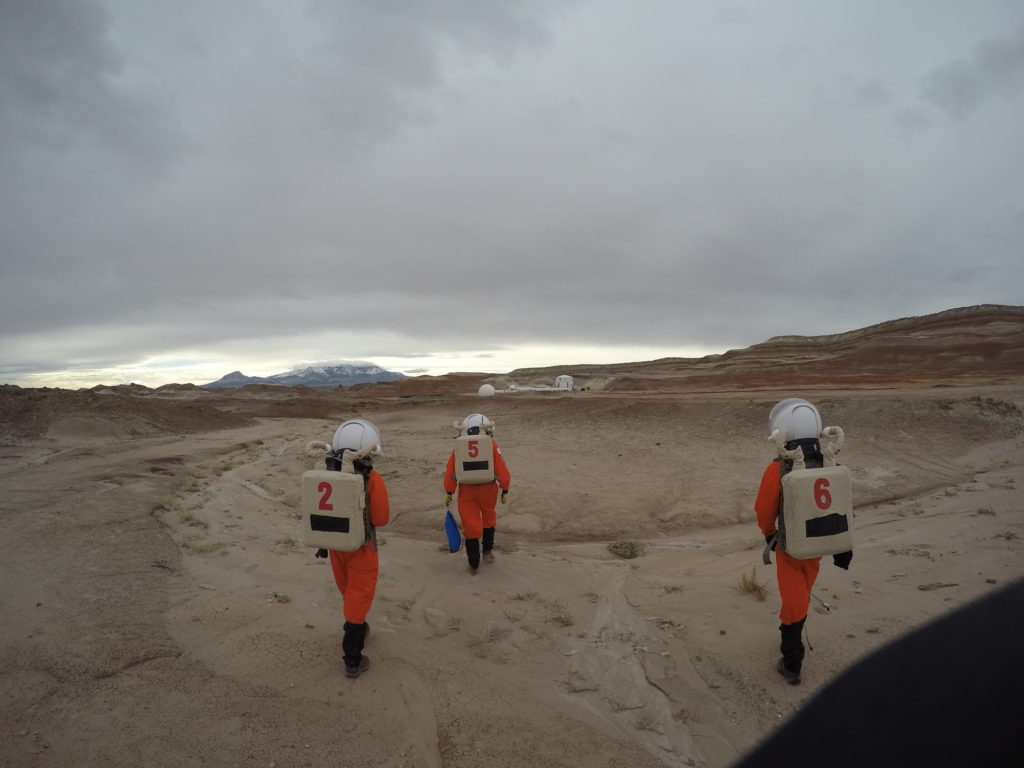






Date: 04/01/2017
EVA Leader: Ilaria Cinelli
Crew members involved in the EVA: Patrick Gray, Pierrick Loyers, Nicholas McCay, Anushree Srivastava
Begin: 10.00 am
End: 12.10 pm
Type of EVA: Walking
Purpose: Exploration for collection of geological samples
Coordinates: 4152000N 110.78W
Purpose: Today EVA starts at 10, sharp. After the engineering check, we started to walk to Galileo road. This was a long walk that my EVA team really appreciates. They have the chance to get used to the suit walking on rocky and sandy soil in long distance walk (in a stunning desert!). We took a long walk to identify locations that were closer to river paths. A few samples were collected on plane sandy soil to measure its dielectric properties.